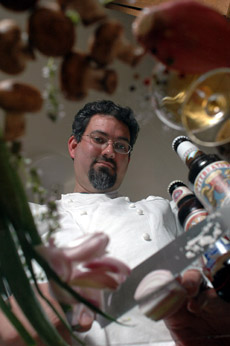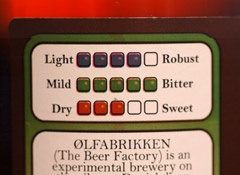 For more about what this is part of look here.
For more about what this is part of look here.
Sean Paxton, the Homebrew Chef, was a professional chef for years and has been a homebrewer since 1993. The meals he prepares annually for Northern California Homebrew Festival are legendary, and he writes a regular food column for Beer Advocate magazine.
In case you forgot, the questions are: If you could invite four people dead or alive to a beer dinner who would they be? What four beers would you serve?
So many people to chose from, yet the more I think about it, the easier the guest list is.
Father Dominique, Abbaye Notre-Dame de Saint-Remy. What we taste today in Rochefort’s 8 and 10, might not be how those two beers started back at the turn of the century without his help. Father Dominique’s improvements to the production and quality of the brewing techniques, ultimately changed the course of the monastery future. To discuss with him what and how the beers were made before and what changes were implemented would make for a pretty incredible evening. Can he bring some samples to share at the table?
Charles Greene. One of the two brothers who brought us the Greene & Greene style of architecture. I see many similarities in highly skilled trade and decorative art using wood, to a brewer designing a great beer for the palate and brewing it. His take on food and beer would add a nice mix to the table.
Matt Bryndilson. Besides being a great brewer (at Firestone Walker), he is also a total foodie at heart. With his crazy blend of last years 10 and soon to be released 11, Matt’s experience in blending beers, aging in oak and hop knowledge, could spark an interesting discussion on the future of brewing. I would also love his take on the meal and beers that were served over dinner. And besides, he’s still alive.
And Michael Jackson. I only met him once and never got a chance to cook for him. That would have been cool, to cook for such an amazing inspiration. That menu would take a long time to create. But, oh the conversation that would come out of it.
The first course would start with a glass of De Dolle Stille Nacht Reserve 2000 aged in Boudreaux Barrels for 18 months. The flavors of toffee, apricots, cherries, grapes, cinnamon and touches of spices that you can almost identify, but meld into another flavor dancing on your tongue. I’d pair this with a selection of Trappist cheeses: Chimay Grand Reserve, Orval and Westmalle Tripel Crème, garnishing the plate with fresh figs, dried apricots, toasted hazelnuts, cinnamon infused honey and a rustic sourdough.
Second beer would be De Struise French Oak Aged Pannepot. When I first tasted this elixir, I thought “Sex in a Glass.” Urbain and his crazy/wild team of brewers created a brew that is perfect with food, or to sit by a fire and smoke a nice cigar. To pair with this treat, I would have to have to do a Seared Duck Breast, cooked a juicy medium rare, on a Bed of Pureed Celery Root, with a sauce reduced from New Glarus Cherry, duck stock and thyme from the garden.
I would have to serve my almost done Saucerful of Secrets to my four guests. With a crazy and complex grain bill, different sugars and a radical fermentation, it would be an honor to pour this for a third course. I would pair a Fig Wood Smoke Rack of Lamb, served with a Fig Coriander Demi and Black Truffle Mash Potatoes topped with Seared Foie Gras to play off the dark fruit flavors in the beer.
And my last beer would be Hair of the Dog Dave. Created by triple freezing Adam, aging it in Bourbon Barrels for 6 months, flavors beyond most ideas of what beer is, wash over the tongue. The fact that It’s over 28% abv and over 10 years old now sure helps . . . I did a Beeramisu for Fred Eckhardt’s 80th with Alan, using this beer and pairing with it. The intense malt flavors pair nicely with the nutty mascarpone and a sprinkle of 120L crystal malt. A nice way to end the evening.
 If you don’t want to drink this beer then I will:
If you don’t want to drink this beer then I will: This is just a great idea from Ølfabrikken, or maybe from Shelton Brothers, which imports the Danish beer.
This is just a great idea from Ølfabrikken, or maybe from Shelton Brothers, which imports the Danish beer. For more about what this is part of
For more about what this is part of  For more about what this is part of
For more about what this is part of